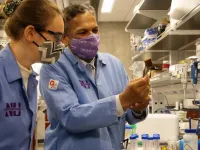(Press-News.org) VANCOUVER, Wash. - A new study in Global Biogeochemical Cycles shows per-area greenhouse gas emissions from the world's water reservoirs are around 29% higher than suggested by previous studies, but that practical measures could be taken to help reduce that impact.
Much of the increase in emissions comes from previously unaccounted for methane degassing, a process where methane passes through a dam and bubbles up downstream, according to the analysis by Washington State University and University of Quebec at Montreal scientists.
Overall, the researchers found the world's water reservoirs are annually producing methane, carbon dioxide, and other greenhouses gases in an amount roughly equivalent to 1.07 gigatons of carbon dioxide.
While that amount is small in comparison to the more than 36 gigatons of greenhouse gas emissions produced by fossil fuels and other industrial sources each year, it's still more greenhouse gas than the entire country of Germany, the globe's sixth largest emitter, produces annually. It is also roughly equal in weight to 10,000 fully-loaded U.S. aircraft carriers.
Led by John Harrison, a professor in the WSU Vancouver School of the Environment, and co-authored by colleagues at the University of Quebec at Montreal, the study is the first to include methane degassing in its estimate of global greenhouse gas emissions from manmade reservoirs.
The research team also factored in numerous other unaccounted for variables into their analysis such as water temperature, water depth and the amount of sediment entering into thousands of different reservoirs located around the world. Previous studies that calculated overall greenhouse gas emissions from reservoirs relied solely on average emission rates per reservoir surface area.
"While a number of papers have pointed out the importance of aquatic systems as sources of methane to the atmosphere, this is the first paper that I know of to look explicitly at which kinds of reservoirs are big sources and why," Harrison said. "It gives us the ability to start working toward understanding what we could do about methane emissions from these types of systems."
Decomposing plant matter near the bottom of reservoirs fuels the production of methane, a greenhouse gas that is 34 times more potent than carbon dioxide over the course of a century and comparable to rice paddies or biomass burning in terms of overall emissions.
Harrison and colleagues found methane degassing accounts for roughly 40% of emissions from water reservoirs. This large increase in previously unaccounted for emissions was partly offset by a projected lower amount of methane diffusing off the surface of reservoirs, according to the analysis. Carbon dioxide emissions were similar to those reported in past work.
The researchers' findings reveal the highest rates of greenhouse gas emissions from reservoirs occur in the tropics and subtropics. An estimated 83% of methane emissions occurred within tropical climate zones.
These areas are also where the majority of ongoing and planned new reservoir construction projects are anticipated to occur in coming decades.
The findings are particularly important because it may be possible to reduce methane emissions downstream from reservoirs by selectively withdrawing water from near the reservoirs' surface, which tend to be methane-poor rather than from greater depths, where methane often accumulates.
For example, in a related study, a simulated decrease in water withdrawal depth by as little as 3 meters (about 10 feet) yielded a 92% reduction in methane degassing emissions from a Malaysian reservoir.
"We aren't saying that reservoirs are necessarily bad. Many provide important services like electrical power, flood control, navigation and water," Harrison said. "Rather, we want to bring attention to a source of greenhouse gas emissions that we think can be reduced in the years ahead as we work towards carbon neutral emissions."
Harrison's and colleagues work recently helped lead the Intergovernmental Panel on Climate Change, the leading international authority on the subject of global warming, to recognize reservoirs and flooded lands as an integral part of each country's overall emissions.
"We're interested in using this work to improve these models and global estimates," Harrison said. "One end goal of this work is to improve our ability to estimate the amount of greenhouse gases coming from reservoirs on a per country basis so that countries can address this source and include it in the way that they are managing their greenhouse gas liabilities."
INFORMATION:
PULLMAN, Wash. - No billionaires live among the Tsimane people of Bolivia, although some are a bit better off than others. These subsistence communities on the edge of the Amazon also have fewer chronic health problems linked to the kind of dramatic economic disparity found in industrialized Western societies.
For a study in the journal eLife, a research team led by Aaron Blackwell of Washington State University and Adrian Jaeggi of University of Zurich tracked 13 different health variables across 40 Tsimane communities, analyzing them against each person's wealth and the degree of inequality in each community. While some have theorized that inequality's health impacts are universal, the researchers found only two robustly associated outcomes: higher blood pressure and ...
Electrical engineers at the University of California San Diego developed a technology that improves the resolution of an ordinary light microscope so that it can be used to directly observe finer structures and details in living cells.
The technology turns a conventional light microscope into what's called a super-resolution microscope. It involves a specially engineered material that shortens the wavelength of light as it illuminates the sample--this shrunken light is what essentially enables the microscope to image in higher resolution.
"This material converts low resolution light to high resolution light," said Zhaowei Liu, a professor of electrical and computer engineering at UC San Diego. "It's very simple ...
An enhanced learning environment during the first five years of life shapes the brain in ways that are apparent four decades later, say Virginia Tech and University of Pennsylvania scientists writing in the June edition of the Journal of Cognitive Neuroscience.
The researchers used structural brain imaging to detect the developmental effects of linguistic and cognitive stimulation starting at six weeks of age in infants. The influence of an enriched environment on brain structure had formerly been demonstrated in animal studies, but this is the first experimental study to find a similar result in humans.
"Our research shows a relationship between brain structure and five years of high-quality, educational and social experiences," said Craig Ramey, ...
New research has shown that if people achieve and maintain substantial weight loss to manage their type 2 diabetes, many can also effectively control their high blood pressure and stop or cut down on their anti-hypertensive medication.
A weight management programme, developed by researchers at the Universities of Glasgow and Newcastle for the Diabetes UK-funded DIabetes REmission Clinical Trial (DIRECT), has proved effective at lowering blood pressure and reducing the need for anti-hypertensive medications, as well as bringing remission of type 2 diabetes.
The programme involves an initial 12 weeks on a nutritionally complete formula diet (low calorie soups and shakes) which will induce weight loss ...
Below please find summaries of new articles that will be published in the next issue of Annals of Internal Medicine. The summaries are not intended to substitute for the full articles as a source of information. This information is under strict embargo and by taking it into possession, media representatives are committing to the terms of the embargo not only on their own behalf, but also on behalf of the organization they represent.
1. Tai chi about equal to conventional exercise for reducing belly fat in middle-aged and older adults
HD video soundbites ...
UCLA HEALTH RESEARCH BRIEF
FINDINGS
A new study shows that tai chi mirrors the beneficial effects of conventional exercise by reducing waist circumference in middle-aged and older adults with central obesity. The study was done by investigators at the University of Hong Kong, The Chinese University of Hong Kong; Chinese Academy of Sciences; and UCLA.
BACKGROUND
Central obesity is a major manifestation of metabolic syndrome, broadly defined as a cluster of cardiometabolic risk factors, including central obesity, dyslipidemia, hyperglycemia, low high-density lipoprotein ...
A new study published in Proceedings of National Academics of Sciences finds that individuals who falsely believe they are able to identify false news are more likely to fall victim to it. In the article published today, Ben Lyons, assistant professor of communication at the University of Utah, and his colleagues examine the concern about the public's susceptibility to false news due to their inability to recognize their own limitations in identifying such information.
"Though Americans believe confusion caused by false news is extensive, relatively few indicate having seen or shared it," said Lyons. "If people incorrectly see themselves as highly skilled at identifying false news, they may unwittingly be more likely to consume, believe and share it, especially if it conforms to their ...
Phosphate pollution in rivers, lakes and other waterways has reached dangerous levels, causing algae blooms that starve fish and aquatic plants of oxygen. Meanwhile, farmers worldwide are coming to terms with a dwindling reserve of phosphate fertilizers that feed half the world's food supply.
Inspired by Chicago's many nearby bodies of water, a Northwestern University-led team has developed a way to repeatedly remove and reuse phosphate from polluted waters. The researchers liken the development to a "Swiss Army knife" for pollution remediation as they tailor their membrane to absorb ...
Very high atmospheric CO2 levels can explain the high temperatures on the still young Earth three to four billion years ago. At the time, our Sun shone with only 70 to 80 per cent of its present intensity. Nevertheless, the climate on the young Earth was apparently quite warm because there was hardly any glacial ice. This phenomenon is known as the 'paradox of the young weak Sun.' Without an effective greenhouse gas, the young Earth would have frozen into a lump of ice. Whether CO2, methane, or an entirely different greenhouse gas heated up planet Earth is a matter of debate among scientists. New research by Dr ...
Art Garfunkel once described his legendary musical chemistry with Paul Simon, "We meet somewhere in the air through the vocal cords ... ." But a new study of duetting songbirds from Ecuador, the plain-tail wren (Pheugopedius euophrys), has offered another tune explaining the mysterious connection between successful performing duos.
It's a link of their minds, and it happens, in fact, as each singer mutes the brain of the other as they coordinate their duets.
In a study published May 31 in Proceedings of the National Academy of Sciences, a team of researchers studying brain ...



